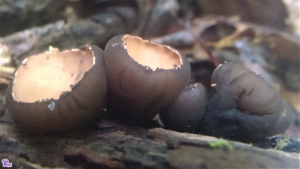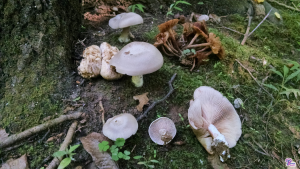#149: Haploporus odorus, the Diamond Willow Fungus or Aniseed Polypore
This otherwise boring polypore has an incredibly strong anise-like odor. Native Americans of the Northern Plains considered this mushroom to have healing and spiritual properties. Haploporus odorus can be found growing on hardwood trees in northern boreal forests. In North America, it prefers the Diamond Willow tree, which gives it the common name “Diamond Willow Fungus.” Another English common name is the “Aniseed Polypore,” which refers to its unique aroma.
H. odorus is a medium-sized polypore that grows from wounds on the sides of living trees. It forms hoof-shaped to shelf-shaped fruiting bodies that grow up to 15cm (6in) in diameter, but may get larger if left alone. The pore surface often runs down the tree somewhat, as if it were smeared on the tree. On top, H. odorus is smooth to finely hairy and pale tan to brown. As the mushroom ages, it may turn greyish and crusty. Underneath, the spore-producing surface is whitish and covered in tiny pores (4-5 per mm). When cut open, the mushroom displays growth lines, much like a tree. H. odorus is perennial, so it produces a new layer of pores every year. Perhaps the easiest diagnostic tool, however, is its very strong anise-like odor, which persists after drying.
This mushroom is parasitic on hardwood trees in the genera Salix (willow) and Fraxinus (ash). However, H. odorus is more likely to be found on willow trees and is almost never found on ash trees in Europe. In North America, it primarily attacks Diamond Willow trees. H. odorus is found in northern boreal forests above 52° latitude, where hardwoods have not quite given way to the conifers that dominate the arctic. It grows in North America, Europe, and Asia. In the United States, it is probably found only in Alaska.
An assessment for The Global Fungal Red List Initiative (a project of the IUCN, which publishes “The IUCN Red List of Threatened Species”) found that there are likely around 200,000 individuals of H. odorus worldwide and that this population is in decline. Between 15% and 30% of the mushroom’s habitat has been lost due to deforestation, livestock grazing, agriculture, and climate change.
However, recognition of the cultural importance of H. odorus has helped protect its habitat in Canada. In 2015, TransCanada consulted with First Nations and decided to use a road bore to tunnel part of a pipeline underground to avoid disturbing a stand of Diamond Willow trees known to harbor H. odorus. Visit the link below* to read TransCanada’s description of this process.
Undoubtedly, the most interesting part of H. odorus is its history of use by Native Americans. The pleasant-smelling mushroom was (and to some extent still is) used for a variety of purposes, mostly medicinal or ceremonial. Unfortunately, much of the knowledge of its use has been lost over the years. Part of the reason for this is that Native American artifacts made from mushrooms were assumed to be made of wood. In the case of H. odorus, the artifacts were assumed to be made of cottonwood roots. This mistake is understandable, since H. odorus is a woody, perennial polypore. It therefore has a wood-like texture and growth lines. Polypore growth lines are generally parallel, since a new layer is formed on the bottom surface, unlike the concentric growth rings found in trees. Of course, this distinction would not be obvious in small objects.
In 1997, Robert A. Blanchette (from the Department of Plant Pathology in the University of Minnesota, St. Paul and known for his previous ethnomycological studies of Native American culture) finally went through museum collections and identified the objects crafted from H. odorus. I will summarize his findings, but I recommend reading his paper (“Haploporus odorus: A sacred fungus in traditional Native American culture of the northern plains”, linked below**), which is quite easy to read and includes some pictures. His paper relies heavily on museum collections and their associated notes. Although most objects were in a less than desirable state of preservation and/or lacked extensive notes, Blanchette was able to get a more detailed picture by examining material from museums all across North America. Since the mushrooms were not left intact, identification was done using detailed microscopic examination.
Blanchette found chunks of H. odorus in collections of various objects from the Northern Plains region, including: medicine bundles, ceremonial robes, necklaces, and human scalp necklaces. On most of these, the mushroom was carved into an oval bead-like shape about the size of a tennis ball and was often decorated with small designs formed from burnt lines. These objects are all of a spiritual nature, which indicates that H. odorus had spiritual power.
One of the primary uses of H. odorus was as medicine. The mushroom was used to stop bleeding and to treat coughs, diarrhea, and dysentery. Necklaces made with pieces of this mushroom were likewise thought to ward off disease. The inclusion of H. odorus on sacred war robes indicates that the mushroom was revered for its general protective powers. When added to scalp necklaces, it likely helped to placate the spirits of the dead. There is at least one report that the fungus was stolen from other tribes, so it was probably often taken as a trophy during battle. The modern Woods Cree use it as a smudge for healing, to call spirits, and to expel bad influences.
Other researchers who have talked to Native Americans about modern uses found that H. odorus is also used as a kind of trance-inducing incense. The mushroom easily catches a spark and burns very slowly. As it burns, it releases an incense-like aroma. In certain Canadian tribes, this is used to help induce a trance that allows communication with the dead.
See Further:
** http://forestpathology.cfans.umn.edu/pdf/Haploporus.pdf
http://iucn.ekoo.se/iucn/species_view/286847
https://blog.mycology.cornell.edu/2010/01/06/mushrooms-as-sacred-objects-in-north-america/
* http://blog.transcanada.com/pipeline-project-protects-diamond-willow-fungus/
http://www.apsnet.org/members/awards/Fellows/Pages/RobertABlanchette.aspx (about Robert A. Blanchette)







![#011: Characteristics of Kingdom Fungi [Archived]](https://www.fungusfactfriday.com/wp-content/themes/hueman/assets/front/img/thumb-small-empty.png)



I have found someone selling some fungus that they claim is h. odorus. I was wondering if someone could tell me if these are actually h. odorus or perhaps something else? I can provide pictures.
I am not an expert in this fungus and cannot ID it from pictures (also, ID by picture is always difficult and often inaccurate). My advice: research the seller as best you can to determine whether or not they have a reputation for providing correctly ID’d mushrooms. There are also numerous Facebook groups that do mushroom ID by picture, although it still helps if you have the actual mushroom so you can assess non-visual features (like odor) as well as features that don’t photograph well.
Thank-you 🙂 I appreciate your help. I didn’t think to look for a facebook group.
yes just inbox my email ranpeet0 @gmail.com and I will tell you if they are..